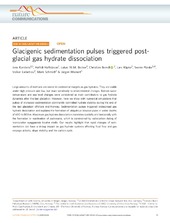| dc.contributor.author | Karstens, Jens | |
| dc.contributor.author | Haflidason, Haflidi | |
| dc.contributor.author | Becker, Lukas | |
| dc.contributor.author | Berndt, Christian | |
| dc.contributor.author | Rüpke, Lars Helmuth | |
| dc.contributor.author | Planke, Sverre | |
| dc.contributor.author | Liebetrau, Volker | |
| dc.contributor.author | Schmidt, Markus | |
| dc.contributor.author | Mienert, Jurgen | |
| dc.date.accessioned | 2018-05-07T07:32:43Z | |
| dc.date.available | 2018-05-07T07:32:43Z | |
| dc.date.issued | 2018-02-12 | |
| dc.Published | Karstens J, Haflidason H, Becker L, Berndt C, Rüpke LH, Planke S, Liebetrau V, Schmidt MA, Mienert J. Glacigenic sedimentation pulses triggered postglacial gas hydrate dissociation. Nature Communications. 2018;9:635 | eng |
| dc.identifier.issn | 2041-1723 | en_US |
| dc.identifier.uri | https://hdl.handle.net/1956/17688 | |
| dc.description.abstract | Sediment cores from the south-eastern Nordic Seas simultaneously archive the variability of the Fennoscandian Ice Sheet (FIS), the British-Irish Ice Sheet (BIIS) and the regional oceanic conditions. This study aims to contribute to our understanding of the marine-based section of the FIS and the BIIS between 35,000 and 15,000 years BP, by using cores MD99-2283, MD99-2284 and MD99-2289, retrieved along the upper continental slope between the Faroe-Shetland Channel and the Vøring Plateau. For this, we present a revised, radiocarbon based, Bayesian modelled chronological framework and a compilation of new and published sedimentological, geochemical and micro-paleontological datasets. Our results show a possibly first Weichselian FIS/BIIS confluence at ca. 25,500 years BP in the central North Sea, which buttressed the BIIS to the East, potentially leading to a northwards BIIS deflection via the Shetlands. The Norwegian Channel Ice Stream (NCIS) most likely only reached the shelf edge after 23,300 ± 500 years BP, possibly for the first time during the Weichselian. The NCIS onset directly preceded a pronounced influx of warm Atlantic water to the northern North Sea margin possibly implying forcing through ocean melt. We find a highly variable NCIS, with three ~ 1400 yearlong episodes of increased ice rafted debris flux interrupted by ~ 600 yearlong minima. When compared to other sides of the European Ice Sheet, these episodes appear to correlate well, suggesting a common forcing mechanism. In conclusion, our data supports recent suggestions that the last glacial stage of the BIIS was more extensive in the central North Sea and the confluence later than previously thought. | en_US |
| dc.language.iso | eng | eng |
| dc.publisher | Nature Publishing Group | en_US |
| dc.relation.ispartof | <a href="http://hdl.handle.net/1956/17689" target="_blank">Ice sheets, oceanic circulation & sea surface conditions: the NW European margin during the last 35,000 years</a> | en_US |
| dc.rights | Attribution CC BY | eng |
| dc.rights.uri | http://creativecommons.org/licenses/by/4.0 | eng |
| dc.title | Glacigenic sedimentation pulses triggered postglacial gas hydrate dissociation | en_US |
| dc.type | Peer reviewed | |
| dc.type | Journal article | |
| dc.date.updated | 2018-05-07T07:29:21Z | |
| dc.description.version | publishedVersion | en_US |
| dc.rights.holder | Copyright 2018 The Author(s) | en_US |
| dc.identifier.doi | https://doi.org/10.1038/s41467-018-03043-z | |
| dc.identifier.cristin | 1564563 | |

